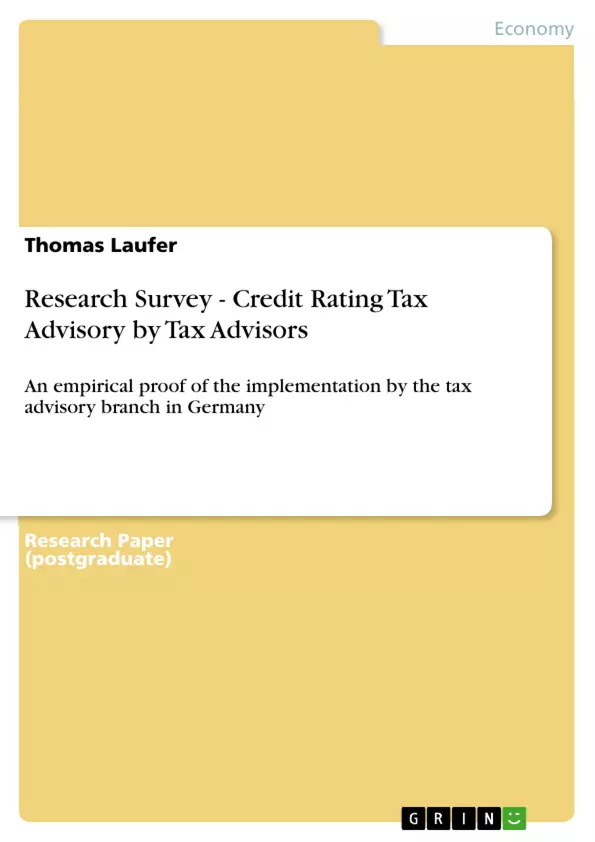The paper explores the options for credit rating consultancy by the tax advisory branch in Germany.
In terms of method in follow-up to introduction and definition, the subject is split into four partial theses. The theses explore in the theoretical part the options provided by the law of tax advisors for credit rating advisory services by tax advisors and training and education options to gain professional competence in credit rating consultancy. In the research part in two surveys, insights are sought on the need for credit rating advisory services and its current implementation status by the tax advisory branch.
The discussion expIores the relevant market potential and respective income potential in fees. A novel aspect this approach entails is exploring the offer side for credit rating advisory services by tax consultants and the resulting insights for the tax advisory branch and individual tax consultancies.
Inhaltsverzeichnis (Table of Contents)
- Introduction
- Basics on Market Trends in the Tax Advisory Branch
- Competitive Pressures upon Tax Consultants by Other Service Providers
- Extension of the Scope of Operations in Response to Market Trends
- Objectives and Methodology
- Main Objectives of the Theses
- Basic Thesis Breakdown into Partial Theses
- Transforming the Partial Theses into Hypotheses
- Generally on the Hypotheses
- Hypothesis from Partial Thesis 1
- Hypothesis from Partial Thesis 2
- Hypothesis from Partial Thesis 3
- Hypothesis from Partial Thesis 4
- Method for Verifying the Partial Theses
- Method for Hypotheses 1 and 2
- Method for Hypothesis 3
- Method for Hypothesis 4
- Methodology of the Empirical Surveys
- Survey of Literature and Research
- Literature on Credit Rating Consultancy
- Current Research Status
- Research Status in Credit Rating Consultancy
- Research Status in the Implementation of Credit Rating Advisory Services
- Results
- Result for Hypothesis 1
- Restrictions on Credit Rating Advisory Services for Tax Advisors
- Verification of Hypothesis 1
- Result for Hypothesis 2
- Qualifications for Tax Advisors
- Verification of Hypothesis 2
- Result for Hypothesis 3
- Return Rate in the Survey
- Evaluation of the Online Survey - Rating Practices by Banks
- Evaluation of the Online Survey - Bank Internal Measures
- Evaluation of the Online Survey - Impact on Rating
- Verification of Hypothesis 3
- Result for Hypothesis 4
- Evaluation of the Online Survey - Current Credit Rating Advisory Services
- Evaluation of the Online Survey - Future Potential
- Verification of Hypothesis 4
- Discussion
- General on Analysis of the Survey
- Market Challenges for Tax Consultants
- Market Challenges for Tax Consultancies
- The Implementation of Credit Rating Advisory Services by Tax Advisors
- Credit Rating as an Area of Operations for Tax Consultants
- Assessment of Market Chances of Credit Rating Consultancy
- The Potential for Credit Rating Consultancy
- Conclusion
- Summary and Results of the Empirical Survey for Banks
- Summary and Results of the Empirical Survey for Tax Consultants
- Summary and Results
- Contribution of the Effort Herein
Zielsetzung und Themenschwerpunkte (Objectives and Key Themes)
This work empirically examines the implementation of credit rating advisory services by tax advisors in Germany. The study aims to understand the market trends and competitive pressures facing tax consultants, and to evaluate the potential of credit rating advisory services as an area of operations for this branch.- Market trends in the tax advisory branch in Germany.
- Competitive pressures on tax consultants from other service providers.
- The potential for tax advisors to offer credit rating advisory services.
- The impact of tax consultant involvement on bank rating practices.
- The future potential of credit rating advisory services for tax consultants.
Zusammenfassung der Kapitel (Chapter Summaries)
- Introduction: The chapter provides an overview of the market trends in the tax advisory branch, highlighting the optimism in the industry in 2005 and the subsequent impact of the economic crisis. It also introduces the study's objectives and research methodology.
- Objectives and Methodology: This chapter outlines the main objectives of the study, breaks down the main thesis into partial theses, and transforms these into hypotheses. The chapter also details the methods used to verify the hypotheses.
- Survey of Literature and Research: This chapter presents a review of existing literature on credit rating consultancy and the current research status in this field. It analyzes the research gaps and identifies areas for further investigation.
- Results: This chapter presents the results of the empirical survey conducted for the study. It analyzes the results for each hypothesis, examining the restrictions on credit rating advisory services for tax advisors, the qualifications of tax advisors in this area, the impact of external rating reports on bank rating practices, and the current and future potential of credit rating advisory services for tax consultants.
- Discussion: This chapter offers a comprehensive analysis of the survey results, focusing on the market challenges faced by tax consultants, the implementation of credit rating advisory services, the potential for credit rating consultancy as an area of operations, and the future outlook for this service.
Schlüsselwörter (Keywords)
The study focuses on the implementation of credit rating advisory services by tax advisors in Germany. Key terms and concepts explored in the study include market trends, competitive pressures, credit rating, bank rating practices, empirical research, and survey methodology. The work also analyzes the current state of the market and the potential for future growth in this emerging field for tax advisors.- Quote paper
- Dr. Thomas Laufer (Author), 2011, Research Survey - Credit Rating Tax Advisory by Tax Advisors, Munich, GRIN Verlag, https://www.grin.com/document/189264



